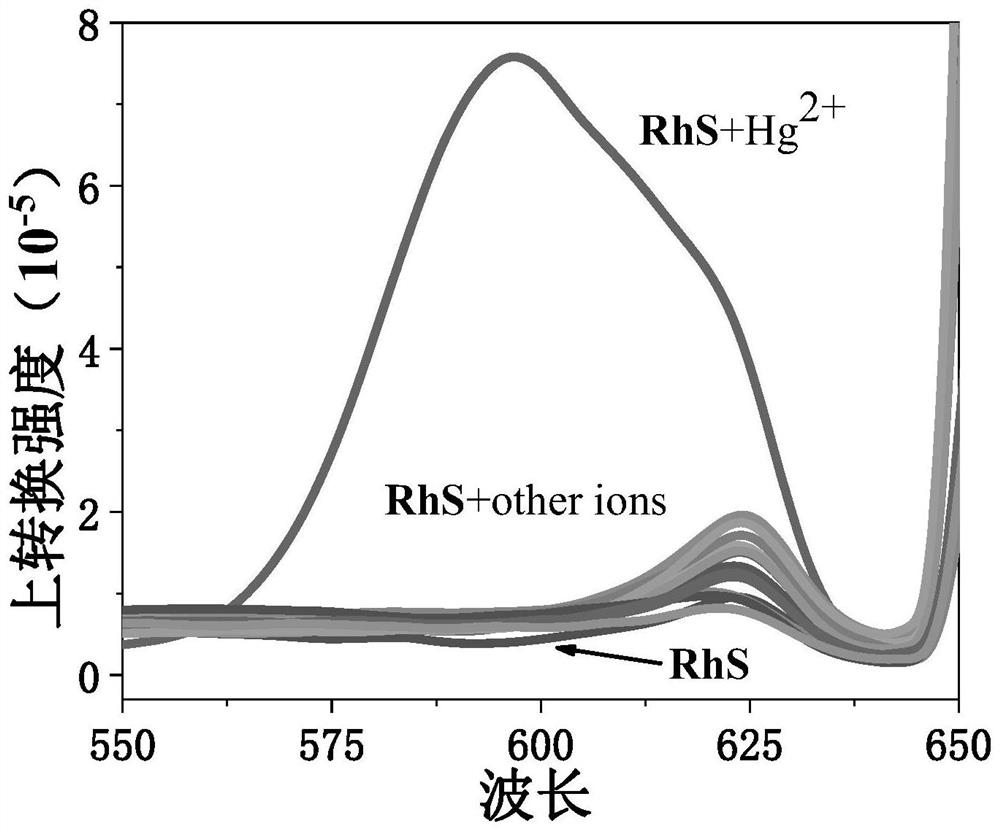Application of rhodamine thiospirolactone in detection of mercury ions by up-conversion fluorescence analysis method
A technology for fluorescence analysis and mercury ions, which is applied in rhodamine thiospirolide (RhS) probes and high-concentration mercury ion detection applications, and can solve problems such as limiting the application of Stokes fluorescence recognition
- Summary
- Abstract
- Description
- Claims
- Application Information
AI Technical Summary
Problems solved by technology
Method used
Image
Examples
Embodiment 1
[0030] Example 1 Preparation of Rhodamine Thiaspirolactone (RhS)
[0031] Rhodamine B (1 g, 2.6 mmol), phosphorus oxychloride (8 mL) and 20 mL of dichloroethane were added to a 50 mL three-necked flask; the reaction was refluxed at 90 °C for 12 h, and the reaction process was followed by spotting, and the developing solvent was Dichloromethane: petroleum ether (1 / 1, v / v), stop the reaction, cool to room temperature; dichloroethane and phosphorus oxychloride are distilled off under reduced pressure to obtain a khaki solid intermediate product (rhodamine acid chloride). In the case of no purification, the above intermediate product was directly dissolved in anhydrous tetrahydrofuran, and thiourea (10 mM, 760 mg) was added; under nitrogen atmosphere, the reaction was carried out at room temperature for 12 h; the reaction process was followed by spot plate, and the developing solvent was dichloride Methane: Petroleum ether (1 / 1, v / v). The reaction was stopped, cooled to room temp...
Embodiment 2
[0033] Preparation of probe (RhS) mother solution: Dissolve a certain amount of probe RhS in dimethyl sulfoxide (DMSO), mix with an equal volume of trimethylolamine methane / hydrochloric acid buffer aqueous solution (pH=7), and prepare A stock solution with a concentration of 2.0 mM was obtained and stored in the dark.
[0034] Preparation of probe (RhS) detection solution: take a certain amount of RhS mother solution and dilute it with different volumes of DMSO to obtain two RhS detection solutions of different concentrations: when used for conventional Stokes fluorescence detection, the RhS detection solution has The concentration is 10 μM; when used for OPA-UC detection, the concentration of RhS detection solution is 0.5 mM.
[0035] Preparation of metal ion solution to be tested: select 16 kinds of metal ions (respectively: Hg 2+ , Pb 2+ , Cd 2+ , Zn 2+ , Cu 2+ , Fe 2+ , Fe 3+ , Co 2+ , Ni 2+ , Mn 2+ , Mg 2+ , Ca 2+ , Na + , K + , Li + , NH 4 + ), and prepa...
Embodiment 3
[0036] Example 3 Probe RhS vs Hg 2+ selective response
[0037] Add 16 kinds (respectively: Hg 2+ , Pb 2+ , Cd 2+ , Zn 2+ , Cu 2 + , Fe 2+ , Fe 3+ , Co 2+ , Ni 2+ , Mn 2+ , Mg 2+ , Ca 2+ , Na + , K + , Li + , NH 4 + ) metal ion aqueous solution (100 μM, final concentration), and the upconversion fluorescence spectrum (OPA-UC detection, excitation wavelength of 655 nm) was measured immediately. attached by image 3 It can be seen that only when Hg is added 2+ Afterwards, broad and strong up-conversion fluorescence appeared, with a peak at ~590 nm, and a very strong orange-yellow fluorescence could be seen from the RhS detection solution with the naked eye. On the contrary, after adding the other 15 metal ions, the OPA-UC spectrum of the RhS detection solution hardly changed, and the RhS detection solution could not be observed to emit fluorescence with the naked eye.
[0038] attached Figure 4 and attached Figure 5 It can be seen that due to the spiro r...
PUM
 Login to View More
Login to View More Abstract
Description
Claims
Application Information
 Login to View More
Login to View More - R&D
- Intellectual Property
- Life Sciences
- Materials
- Tech Scout
- Unparalleled Data Quality
- Higher Quality Content
- 60% Fewer Hallucinations
Browse by: Latest US Patents, China's latest patents, Technical Efficacy Thesaurus, Application Domain, Technology Topic, Popular Technical Reports.
© 2025 PatSnap. All rights reserved.Legal|Privacy policy|Modern Slavery Act Transparency Statement|Sitemap|About US| Contact US: help@patsnap.com



